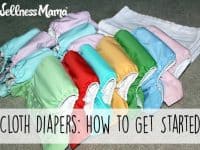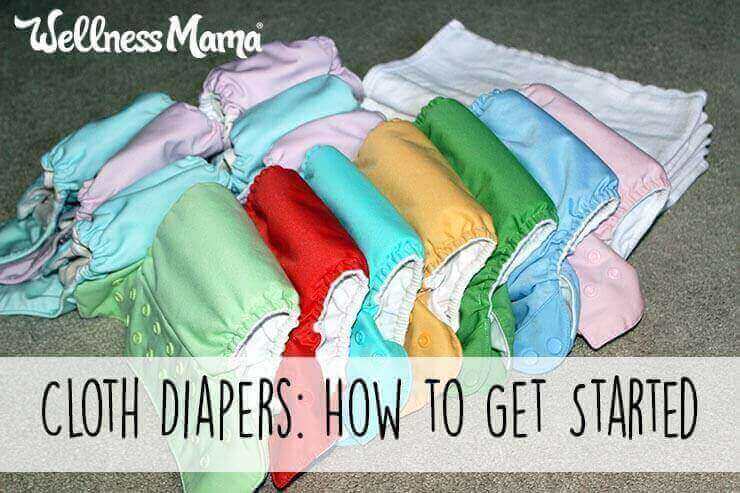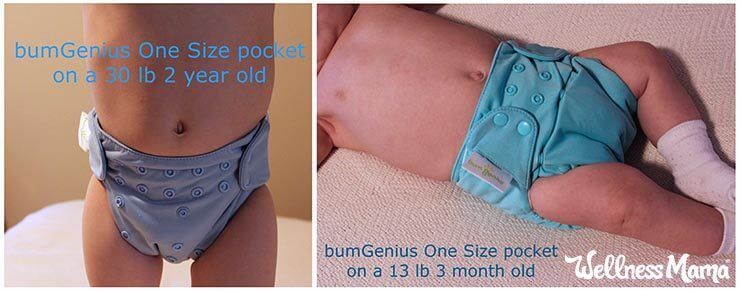

The decision to cloth diaper is easy for some. But if you are like me, there are a million questions that need to be answered first. Cloth diapering today is so different from the way our grandmothers did it. I have talked to many women who remember cloth diapering to be a burdensome task that they were not sorry to see go with the dawn of “paper diapers.”
Thankfully, cloth diapers have changed! We have high-tech washing machines, advanced fabrics and designs, and a wealth of information via the Internet to aid us in the task. I also know that cloth diapering is not for everyone, so check out the bottom of the post for some non-cloth eco-friendly options.
Cloth Diapers: Things to Consider
There are a few things to consider before you begin your research that will aid your decision-making process. What is your primary reason for choosing cloth diapers? Reasons may include cost, health of baby’s skin, protecting the environment by cutting down on waste, or simply because they are just so soft and cute!
Next, it is wise to determine your budget. I recommend doing this ahead of time because once you start looking at all of the cute patterns available it is difficult to control the urge to buy them all!
Once you know your reason for cloth diapering and have a budget in mind, you can then begin your search for what diapering system will best meet your needs. Some people like a variety and some prefer all one type. I have gone back and forth between having a diverse collection and wanting everything exactly the same for ease of use, washing, and storage.
How Cloth Diapers Have Changed
Diapering has evolved tremendously over the years. From ancient times when babies were wrapped in leaves and animal skins to the more “modern” flat which consisted of a large square piece of cotton flannel or muslin which was folded and fixed with pins. Women had almost no alternatives when it came to diapering their children and were at the mercy of what limited resources they had on hand. Today, mothers have countless options to choose from and cloth diapers have not only become very easy to use and care for, but they are cute too!
In the last 20 years the biggest changes have been the type of materials used and the style and shape of the diaper. Plastic pull-on covers have been replaced by PUL (polyurethane laminate) or wool. Square, flat muslin diapers have been replaced by fitted styles with snap or hook and loop closures.
PUL is a breathable, tight-knit polyester which is laminated to make it waterproof. Covers made from PUL are usually paired with a fitted cotton diaper and allow heat and water vapor to pass through but keep wetness locked inside. These covers can have specific sizes or can be made with different snap settings that allow the diaper cover to grow with your child.
Wool also makes an excellent cover because of its natural ability to absorb moisture while still allowing for good circulation of air, keeping your little one’s bottom cool. You might be thinking, “Wool!?” But I assure you, wool makes an excellent choice for a diaper cover (here’s why).
Probably the most important feature of a cloth diaper is the absorbency. I can only imagine what it must have been like to try to contain a baby’s “deposits” with leaves! When women began using fabric scraps they must have felt like queens! But even more absorbent and user friendly than fabric scraps are the soft, fitted cloth diapers we have today.
In addition to increased absorbency, modern diapers make use of elastic in the leg area to help contain messes. Gone are the days of leaky, messy babies. I have found that I have almost no blow-outs (you know what kind I am talking about) with cloth. In fact, on rare occasions when I have used a disposable, I still put a PUL cover on over the disposable because they are so much more effective at containing messes.
As long as there are babies, there will be a need for diapers and these new features make cloth diapering easy. However, this is not to say that many back-to-basic mothers have not made great use of the classic flat or pre-fold as part or all of their diapering stash. There are so many options that it is easy to find a system that works best for you and your baby.
Cloth Diapering Systems
Basic Cotton Diapers and Cover System
The basic cotton diaper/cover system is still widely used. Flats and prefolds (essentially flats that are “pre-folded” for you) are easy to wash and are very inexpensive. Paired with a collection of one-size covers, flats and prefolds make it possible to cloth diaper for around $100.
They are not as good at containing messes and there is a learning curve with the different folding techniques, but they do dry quickly which is a huge plus in energy savings. These basic cotton diapers require a PUL or wool cover like the ones mentioned above. If you are looking for an affordable, healthy way to diaper your baby, this is a good option.
Fitted Diaper Covers
Another diaper/cover style is the fitted. It works like the flat in that it needs a cover, but the diaper itself is fitted to the baby with a contoured shape and elastic legs. This can also be an economical system that is a bit easier to use than the flat diaper because there is no folding involved. Fitted diapers also do a better job than flats at keeping the poo in.
Pocket Style Covers
The pocket style is my personal favorite. They consist of an outer, waterproof shell with a stay-dry inner fabric that is sewn together to form a pocket. The pocket is then “stuffed” with an absorbent liner, usually microfiber or cotton. The legs are elastic and they have a built-in closure system so there is no pinning required. Diapers like BumGenius and FuzziBuns are shaped just like a disposable diaper. They have a snap or hook and loop closure and are extremely easy to use. Pocket diapers are often one size, meaning they grow with your baby. What this means is that one set of diapers is all you will need for your little one. They are slightly time consuming because they must be stuffed after they are washed.

The hybrid system, as the name suggests, is a mix of two different styles. The constant component is the cover. From there you have an option to use either a fabric liner, similar to what is put into the pocket in a pocket diaper, or a disposable liner (usually biodegradable and often organic) that is thrown away when it is soiled. Flip by BumGenuis and gDiapers are examples of hybrid systems. If you use the cloth liners these can be very affordable but the disposable liners can be pricey.
All In One Style
All-in-one (AIO) diapers are by far the simplest to use. They are similar to a pocket but the absorbent liner is permanently attached and does not need to be stuffed. AIO diapers are great for dads and daycare because they are most similar to a disposable. They can be pricey because each size will have to be purchased separately. Another drawback is that they do take longer to dry because all the layers of absorbency are sewn in.
Cloth Diaper Accessories You Might Need
You really don’t need many accessories when you use cloth diapers. Some things you will need include:
- A pail for storing the diapers
- a wet bag for when you are out and about
- pins or a Snappi if you use flats or prefolds
- a stack of wipes (you can also use baby washcloths)
- scent-free laundry detergent
I use an old peri bottle filled with water to dampen the wipes before I use them. You can also make your own wipes solution. Some other items that are not necessary but make things easier are a diaper sprayer, biodegradable liners for easy poo removal, spray bottom cleaners, and a wipes warmer.
With cloth diapers, babies rarely get diaper rash. If your baby were to get a rash, it is important to choose a diaper cream without any fish oil in it. I experimented once with diaper cream to see why this was not advised and it turns out the fish oil smell NEVER goes away! Take my word for it. Straight coconut oil works wonders on little bottoms and is safe for cloth diapers. (You can also try a homemade recipe like this one and omit the fish oils).
Storing and Washing Cloth Diapers
There are differing opinions on how to store soiled cloth diapers that are waiting to be washed. Some store in a wet pail, meaning the diapers are placed in a pail of water so they can soak until wash day. I have never done this. It was not practical for me because I have a front-loading washer and I couldn’t figure out how to load the diapers in without flooding nasty water all over the floor. I also felt uncomfortable with the dangers of having a pail of dirty diaper water in my home with little ones running around. So I opted for the dry pail method which is essentially a medium sized trash can lined with an old pillow case.
I usually place a lid on my pail to keep mischievous toddlers out, but in the past I have left the lid off which I discovered allows the diapers to dry a bit and they become less stinky. You can also line your pail with a large waterproof pail liner or even use it alone if you prefer.
Wet diapers can go straight into the pail as can all diapers from exclusively breastfed babies. Soiled diapers from formula fed babies and those children who have started solids will need to be scraped off into the toilet before they are tossed in the pail.
Before you get grossed out and stop reading, did you know that disposable diaper packages also ask you to shake solids off into the toilet? I was surprised to find this out, but now I use this bit of information as a response to people who tell me cloth diapers are yucky (like my husband!). Diaper sprayers are very helpful with removing solids and you can usually just turn the diaper inside out and give it a few shakes.
It is advisable to wash every 2-3 days to prevent the diapers from getting overly smelly. There are probably as many unique wash routines as there are women cloth diapering their little ones. There are so many factors that come into play when determining what works best for you and your diapers, including water composition, types of diapers, the age of your child, what your child is eating, what kind of washer you have, laundry detergent, and on and on. All of these play a roll and it may take a bit of trial and error to get it right.
While my babies are exclusively breastfed my wash routine is very simple. I pre-rinse on cold to help prevent staining and wash on a hot, delicate cycle (the delicate cycle uses more water in my machine) with a quarter of the recommended amount of a free and clear detergent. Country Save has been my favorite although I have used others that I can get locally.
Finally, to prevent detergent residue, I run another complete wash cycle with no added soap to give the diapers a thorough rinse. As I introduce solid foods, the diapers tend to take on a certain stink about them and so I will sometimes use more detergent or run an extra rinse cycle. Over the years I have tried additives to the wash cycle but I find that using enough detergent to get them clean but then rinsing enough to prevent residue is what works best for me. I hang my covers on a rack and dry everything else on medium heat.
It is also wise to thoroughly read the washing advice given by the manufacturer of the diapers you purchase as some may not recommend drying certain diapers or covers. They may also have tips for washing their diapers that will help reduce any build-up or unnecessary wear and tear.
How Many Diapers to Buy?
With a diaper/cover system or a hybrid system, I would recommend 24-36 diapers with 6 covers for the infant stage and 18-24 diapers with 4 covers for a toddler. With a pocket system or AIO, 24-36 is good. Remember, the more diapers you have in your rotation, the less washing and wearing each one receives, therefore the longer they will last. I have at least 48 diapers in my stash and I have been able to use my diapers for more than one child.
So, for example, if you plan to wash every 3 days and your infant will need to be changed every 3 hours, you will need at least 24 diapers. Be sure to buy a few more than you figure because you don’t want to be stuck without a diaper while the others are washing. Basically, determine how many diapers your child wears in a 24 hour period and multiply it by however many days you will go between washing. And keep in mind that cloth diapers need to be changed slightly more frequently than disposable diapers.
If you are considering cloth diapers but are hesitant to take the plunge, there are great online communities like Diaper Pin where veteran moms are available and more than happy to answer any questions you may have.
Can’t Handle Cloth Diapering Right Now?
As I said, while cloth diapers can be an excellent way to save money and avoid exposing baby’s delicate skin to chlorine and other harsh chemicals, they aren’t the best choice for all moms. Even for our family, I’ve used disposables at times, especially when we are traveling or if there are other factors that make it difficult to use cloth.
Thankfully, just as cloth diaper options have come a long way in recent years, so have disposable. There are now options for chlorine and plastic free biodegradable diapers and they aren’t much more expensive than name brand disposable diapers. These are my favorite disposable option, but there are several other great choices available as well.
Have you ever thought about using cloth diapers? If you already use them, what is your favorite type?
Continue Reading...Cloth Diapers: How to Get Started
from Wellness Mama » Blog http://wellnessmama.com/61634/cloth-diapers-get-started/?utm_source=rss&utm_medium=rss&utm_campaign=cloth-diapers-get-started
via SEO Derby
No comments:
Post a Comment